SURVIVAL OF THE FASTEST
This article is from our archives and has not been updated and integrated with our "new" site yet... Even so, it's still awesome - so keep reading!
Published on Sun, Sep 28, 2003
By: The LACar Editorial Staff
SURVIVAL OF THE FASTEST
By HARVEY SCHWARTZ
All Photos & © by Harvey Schwartz
The new 2003 Mitsubishi Lancer Evolution is the closest thing to putting on your racing shoes, firesuit, helmet and getting behind the wheel of a real rally racecar. I had so much fun driving the new Mitsubishi Lancer Evolution that I really didn't want to return it after my 7-day stint behind the wheel.
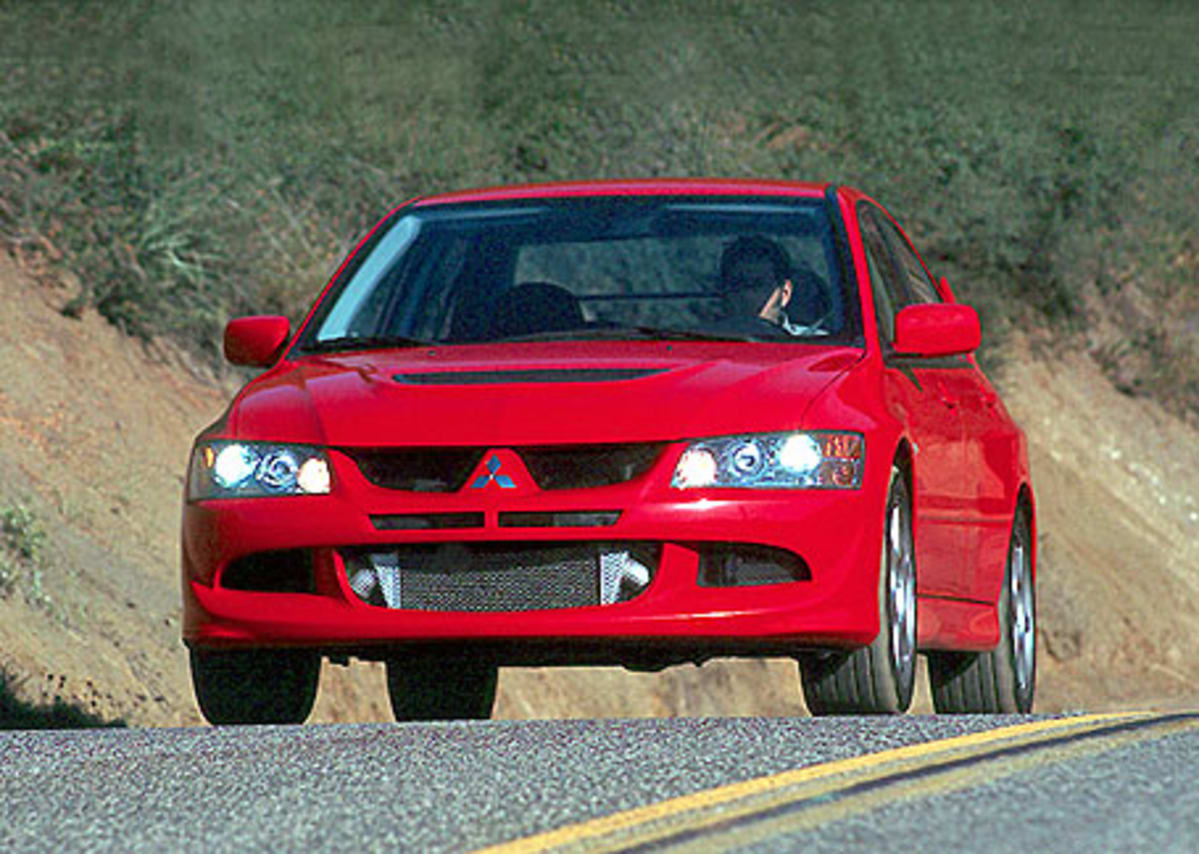
The Mitsubishi Lancer Evolution has been on sale in Europe since 1992 with this latest version called EVO VIII. In the states it is called the Evolution. The Evolution has so much going for it-bold, aggressive, rally car looks including a big carbon fiber rear spoiler, a potent turbocharged engine with an automatic/manual water spray button for the air-to-air intercooler, a close-ratio 5-speed shifter, all-wheel drive, fully independent suspension, big, strong brakes, and sticky Yokahama tires wrapped around 17X8in.Enkei light alloy wheels. Inside you get a MOMO steering wheel, a leather topped shifter, Recaro high-back bucket seats, and a big tachometer in the center of the instrument cluster. The only thing missing was a full roll-cage behind the front seats. America has a new rally bred racecar to compete against the new Subaru Impreza WRX STi that has also been on sale in Europe and now the states. It's about time we enjoyed real heart pumping and adrenaline rushing excitement. This hot 4-door sedan won't break your bank account either as the base price is only $28,987.00. When you add the optional carbon fiber spoiler, a 'must have' at $480.00, and the destination charge of $595.00, it is only $30,062.00, very affordable for most enthusiasts. From any angle, the Evolution shows it's aggressive styling. The front of the Evolution was designed to manage airflow to create downforce and combat engine heat. The aluminum hood has a large mesh cover and kick-up that lets heat out. The front fascia features HID lamps, projector high beams and amber turn signals behind clear lenses. In the center is the signature Mitsubishi split grille and logo, just below are two small slits and below is a large opening channeling air directly into the intercooler. Off to the sides are ducts to cool the front brakes. It is quite impressive and adds to the excitement when you get behind the wheel. A plastic aero-undercover, designed to reduce drag and lift, is mounted beneath the front fascia and includes ducted channels that direct air toward the brakes, transfer differential and transmission for more effective cooling. The aluminum front fenders have been widened to bulge gently from the side of the car to accommodate the Lancer Evolution's wider track without significantly increasing aerodynamic drag. In the rear are big tail, brake and backup lamps behind clear lenses. The rear fender blisters are integrated into the body's sheetmetal instead of attaching to the fender as an extension assembly.
Integrated onto the top of the rear lid cover is a large optional carbon fiber
spoiler. This new wing is thinner yet more rigid than previous designs and features
a reduced cross-section that helps reduce drag. A lower profile, composite plastic
GT wing is also available that adds sporty, race-oriented appeal to the vehicle
for consumers who favor an alternative to the large, competition-minded carbon
fiber wing. Mounted on the right side of the lower bumper is a 4in. round chrome
plated exhaust tip. From the side you see the profile of a rally racecar with
bulging fenders stuffed with Yokohama P235/45R17in. Advan Performance tires
wrapped around 17X8in. Enkei light alloy wheels, lower rocker panels, swept-back
windshield, aero-designed power-remote side mirrors and flat, pullout door handles.
The new Evolution is lean and mean, a real thrill machine.
Lift the hood and check the potent, high-revving 2.0liter DOHC, I-4 making a
heady 271hp at 6,500rpm and 273lb.ft. of torque at just 3,500rpm. The engine's
reciprocating assembly has been suitably reinforced with forged metal components
to better withstand the increased cylinder pressures of forced induction. Forged
connecting rods, and forged aluminum pistons spin from a rugged forged steel
crankshaft that is located at the bottom of a cast-iron cylinder block. An aluminum
cylinder head with high-velocity intake ports and four valves per combustion
chambers endow this motor with excellent breathing characteristics that are
exploited by exhaust-driven forced induction
The combustion chambers are fed up to 19.0psi of pressurized ambient air by
a turbocharger whose design is optimized for improved throttle response and
increased torque through the rpm range. The turbocharger's exhaust gas-drive
turbine wheel is surrounded by a twin-scroll housing that helps direct and maintain
exhaust gas velocity over the turbine wheel at lower speeds to improve engine
response in the low-to-mid rpm range. A lubricated shaft connects the turbine
to a compressor wheel whose impeller design helps build boost earlier, reducing
lag and improving response across the rev-range. The pressurized air fed to
the engine is cooled using a large front-mounted air-to-air intercooler. An
additional air charge cooling efficiency is gained by the use of a water spraying
system that lowers intercooler temperature with either a manual or automatic
spray mode (this button is found just behind the stick shifter). Fuel delivery
for the 4-cylinder engine is by multi-port fuel injection with a computer control
that also governs ignition timing. This single ECU is programmed with fuel and
ignition maps that help maximize the engine's useable torque across the
rpm range while still meeting stringent LEV1 and LEV emissions requirements.
The Lancer Evolution sedan uses a large-diameter (60.5mm) free-flowing exhaust
system that reduces backpressure and includes a catalytic converter and two
sound-absorbing pre-mufflers. The growl when you mash the throttle is impressive
but not like the sound of a muscled V8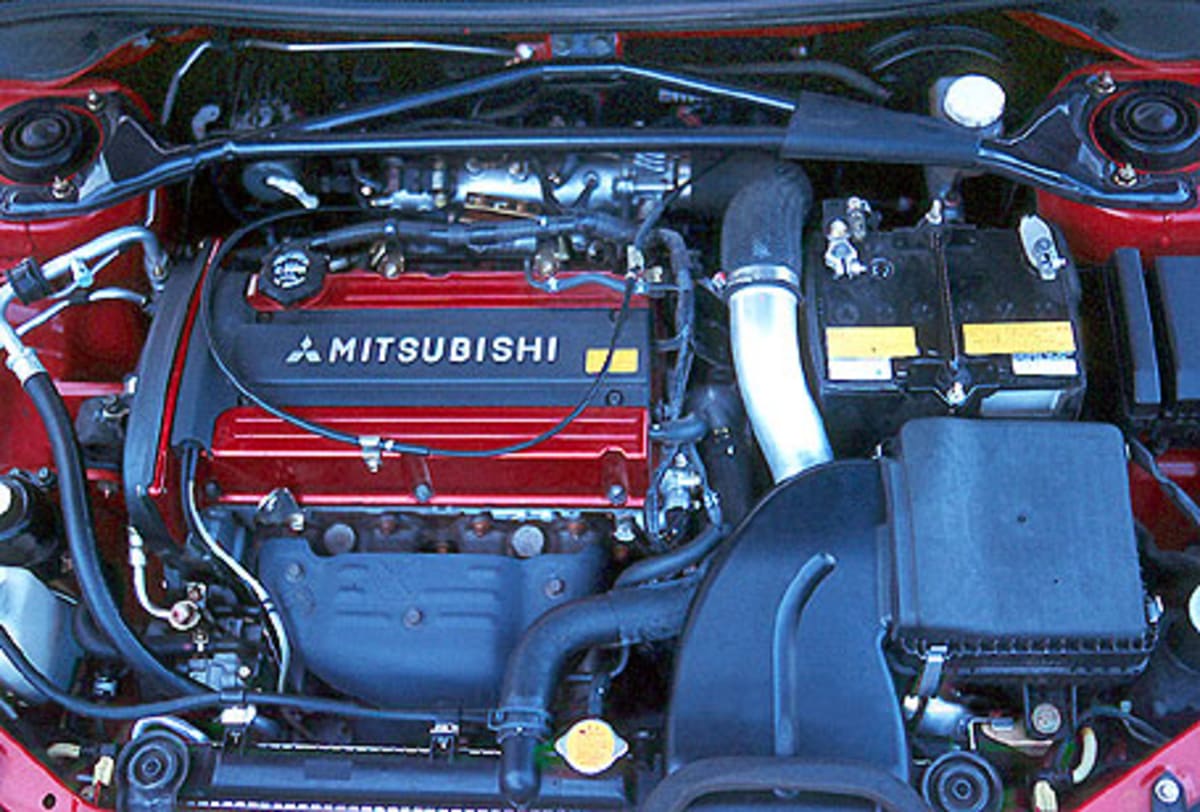
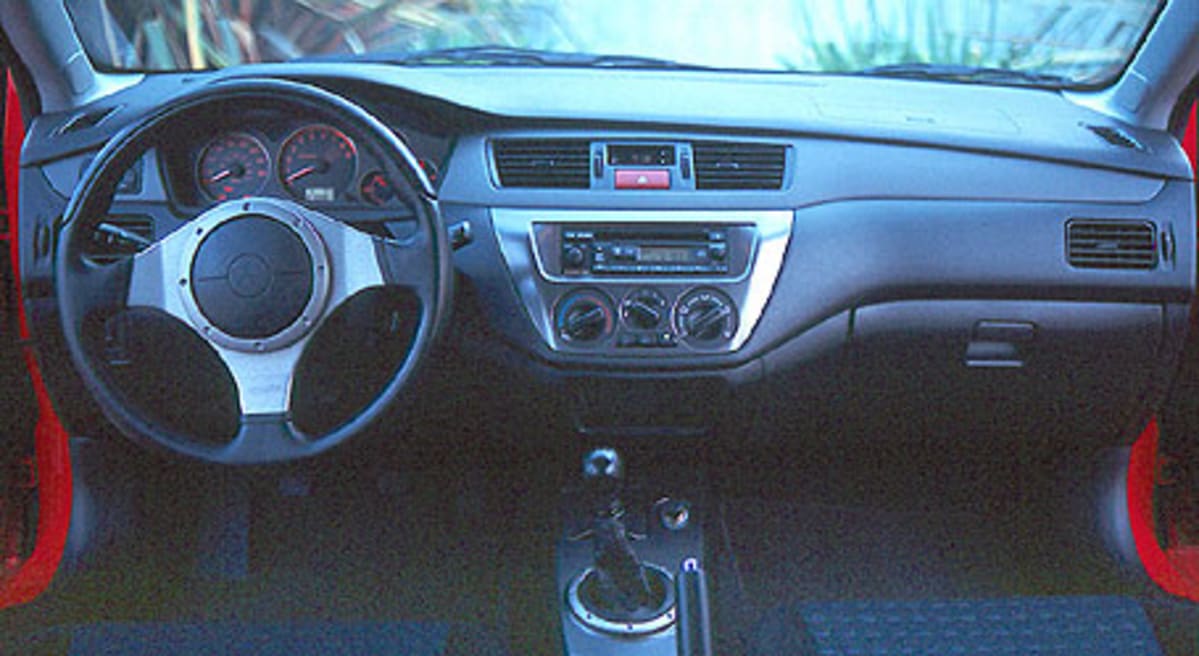
This is what really separates the Evolution from other sedans that I have recently tested-a torsional stiff, chassis, great acceleration, all-wheel drive, neutral 60%-front/40%-rear weight distribution, and a superior fully independent suspension. Only a few sedans and sports cars can replicate the handling prowess of the Evolution slicing thorough corners and dicing through twisting roads. It feels as if you are turning while leaning up against a wall. You feel no body lean at all and experience no understeer or oversteer. The car turns with just a flick of your wrist, just like a racecar. If you turn the wheel too much you can experience some oversteer or understeer. The unique suspension system is all business with a setup that features, up front, large diameter, gas-charged, inverted MacPherson struts, forged aluminum upper and lower control arms, to minimize weight, and a rugged 24mm stabilizer bar equipped with pillow-ball bushing end-links that offer better movement and improve the stabilizer's efficiency, function and stability. A large, supportive, steel, unibody crossmember connects the left and right lower control arm mounts and hops increase lateral rigidity with additional stiffness to improve steering feel and response, which I will get to in a minute. The rear suspension is a multi-link wishbone design with big, coil-over gas-charged shocks, forged aluminum lower arm, forged aluminum trailing and lateral links, a forged aluminum toe control arm, a forged aluminum crossmember and 22mm stabilizer bar with double pillow ball links. To further enhance stiffness and handling is a large strut tower brace with an additional strut brace mount in the center to increase stiffness even more. The Evolution uses a quick-ratio (13:1) power assisted rack & pinion steering system that produces fast steering response and improved maneuverability. It is amazing how quickly the car moves left or right when you flick your wrists. It is sometimes scary because you have to keep your focus on the road at all times or the car can leave it in a heartbeat. Specs for the new Mitsubishi Evolution are plenty fast-0-60mph in just 5sec., the 1/4mi. passing in just 14sec. at 97mph. It gets through the 490ft. slalom in a fast 48mph. On the 200ft. skipad the Evolution pulls a near-supercar 0.96g's.
The standard Brembo aluminum opposed calipers and rotors insures that you will
quickly slow down for curves up ahead, and bring you to a safe and secure stop
whenever necessary, with ABS and Electronic Brake Force Distribution. Up front
are 12.65in. vented rotors clamped with a 4-piston caliper while the rear vented
rotor is 11.8in. and clamped with a dual-piston caliper. It only takes the Evolution
100ft. to stop from 60mph, that's shorter than a Z06 Corvette, Porsche
911 or Ferrari 360. It's all business behind the wheel of this rocket ship
but you can relax and enjoy the ride when you are not in a hurry.
Inside is a spacious, four-passenger layout that features many of the regular
Lancer sedan features and strictly race-bred features of the Evolution. A large
titanium-hued accent panel is added to the center console controls and extends
across the dash. The door panels and center console armrest are the same comfortable
padded assemblies found in the Lancer sedan. Unlike the Lancer sedan, the Evolution
interior is available in only one mood-regulating interior hue, dark blue and
black This more serious color scheme speaks to the purposeful nature of the
Lancer Evolution's all-business racing-oriented interior. With a leather
wrapped and tilting, 3-spoke MOMO steering wheel, a leather covered shift knob,
and very supportive Recaro racing seats, it becomes obvious that Lancer Evolution's
interior means driving excitement. The instrument cluster features a large,
9,000rpm tachometer in the center with a smaller 160mph speedo to the left and
smaller gauges for fuel and engine temperature to the right. A third gauge has
the Lancer name but I wish that it contained a boost gauge or oil pressure gauge.
Bright LED readouts warn of system or safety problems. The black-faced, red-accented
gauges are easy to see. The leather covered parking brake lever is properly
placed to the right side of the stick shifter. The performance-minded interior
includes convenience features such as: a 6-speaker, 140watt Mitsubishi AM-FM
radio with CD player, a headlight leveling control knob, dual vanity mirrors,
dual cupholders up front and rear cup holders in the flip down center armrest,
keyless entry, a trunk entrapment release handle, power windows/door locks,
electronic cruise control, variable speed washers/wipers, including a rear wiper/washer,
full-perimeter thick-pile carpeting with floor mats featuring the Evolution
logo, as well as child door locks in the rear and 10.2cu.ft. of rear trunk space.
The gas tank holds 14-gallons of fuel for a 300mi. cruising range.
For safety, the Evolution comes standard with Next Generation front airbags,
3-point safety belts at all four seats with pretensioners and force limiters,
a reinforced safety cage, a latch system for child seat anchors & tethers,
front/rear crumble zones, and steel beams in each door.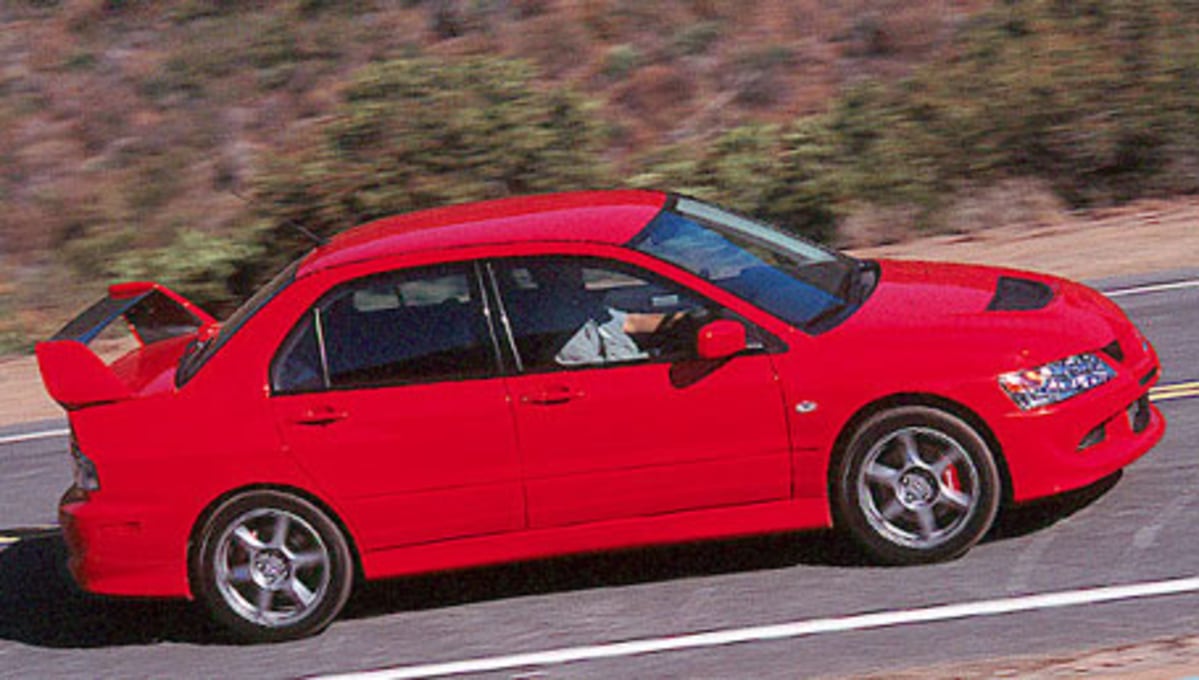
The new Mitsubishi Evolution has it all-unique, aggressive looks, a very potent
4-cylinder turbocharged engine, all-wheel drive, a race bred suspension system,
powerful Brembo brakes and a race inspired interior with many features seen
in the regular Lancer sedan. Who says that you can't have your cake and
eat it too? If you are looking for affordable rally racecar thrills and chills,
test-drive this new 4-door road rocket from Mitsubishi. It's finally here
and affordable.
COPYRIGHT:2003:HARVEY SCHWARTZ
More photos from Harvey Schwartz can be found at www.autofotos.com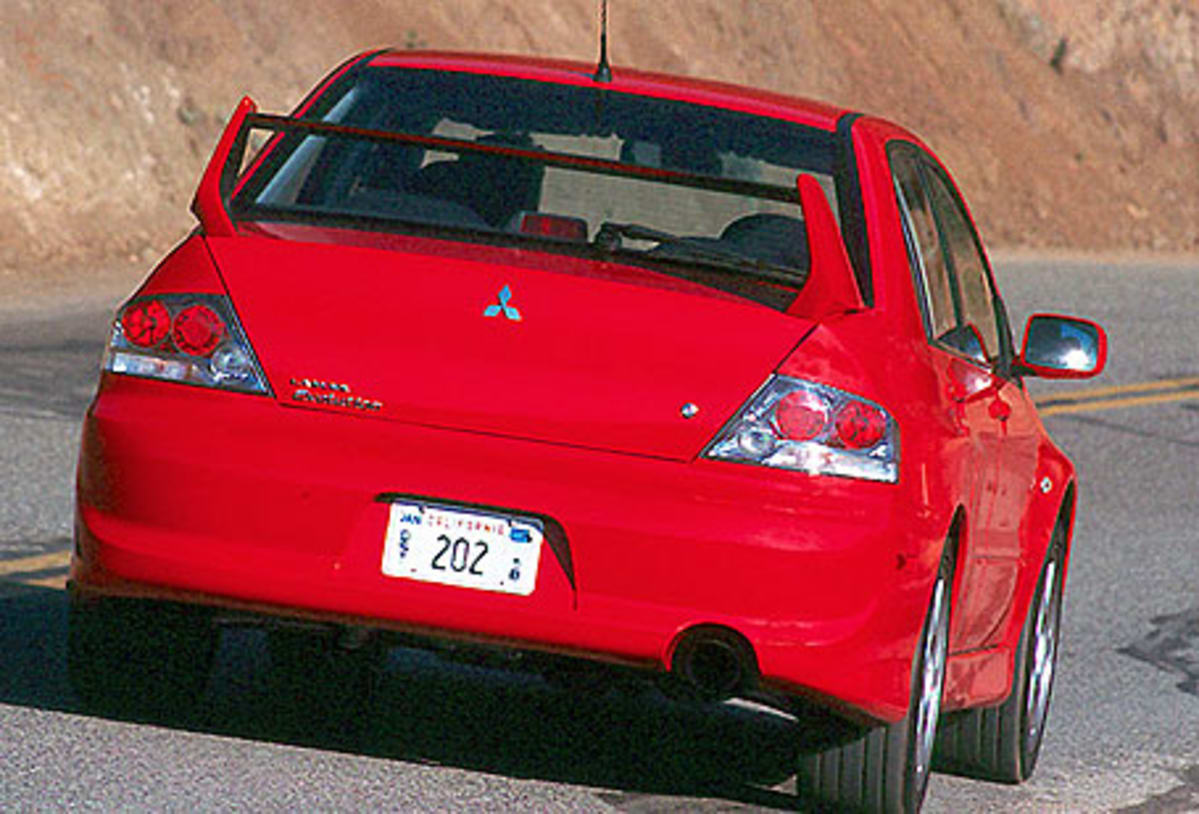
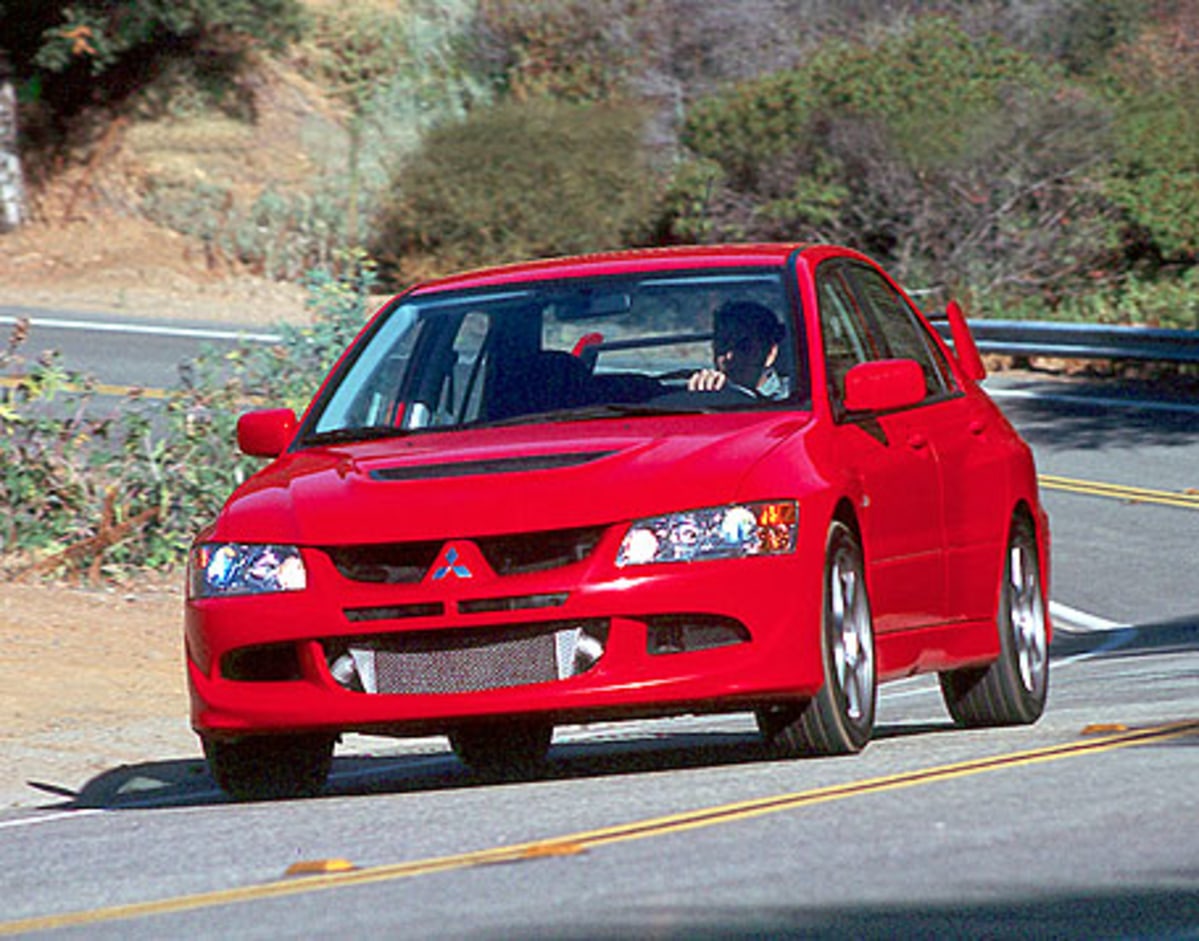
SIDEBAR COMMENTS: This little car is one BMF. This car is capable of generating big numbers... for the county coffers, that is. If you have this car long enough you will get a ticket. There are no maybes about it. Faster than a speeding bullet and super hero comic books styling are just the right elements for adding points to anyone's driving record. Only well calculated leaps to hyperspace should be contemplated. This super stiff suspension on one hand allows this car to stick like superglue. On the other, every divot and crack in the road finds its way to the seat of your pants (this is excitement that you really feel). If life is getting just a little too dull, this car will change your life radically in a big hurry. Of course instead, you can always opt for an ever-popular nose ring! - John Grafman
Every now and then, a car appears on the road that totally bogarts the attention of the fast and furious crowd. In 2002, it was the WRX. This past year, it was the Mitsubishi Evolution VIII - a star of this summer's popular sequel film, Too Fast, Too Furious. Long a fixture of car chase video games, the Evo is this year's IT car. Not since the aforementioned WRX have we seen so much attention paid by the young and the restless over a press fleet vehicle. On the freeway, the Evo seems to bring out the worst in the drivers around it, as everything from Honda Civics to Hyundai Tiburons all of a sudden have an urge to drive aggressively. At lunch, a gal in a lowered Lexus IS300 gives the Evo a double-take. Driving home through San Gabriel Valley, a young passenger in a utility truck leans his torso out the window and gives the Evo a big thumbs up. $30,000 can buy an awful lot of car these days. And spending that much for a car that looks like a Lancer sub-compact makes no sense to some people. There are others, however, who will spend $15,000 on a Honda Civic and have no problem spending another 15 on aftermarket parts. In this context, the Evo makes a lot of sense. Not only does the Evo out-perform most of these tuner cars, it carries a whole lot more moxie. In the popular video game, The Need for Speed, the Evo keeps company with Lamborghinis, Ferraris, Porsches, and the like. How many $30,000 cars can you say that about? - Roy Nakano
More information can be found at www.mitsubishi.com
SPECIFICATIONS Price: $30,062.00 as tested Engine type: 2.0liter, turbocharged, DOHC 4-cylinder engine with cast iron block/aluminum heads Horsepower: 271 at 6,500rpm Torque: 273lb.ft. of torque at 3,500rpm Drive configuration: front engine/all-wheel-drive Transmission type: 5-speed manual, no automatic available Suspension: Front -MacPherson strut with inverted shock absorber and forged aluminum lower control arms, coil springs, stabilizer bar, front strut tower Rear - multi-link wishbone configuration using forged aluminum trailing links and lateral links, coil-over gas-charged shocks, and an aluminum crossmember with stabilizer bar. Wheels and tires: P235/45R17in. Yokohama Advan performance tires/17X8in. Enkei lightweight alloy wheels Brakes: Front - Brembo ventilated discs-12.65in. rotors/4-piston caliper Rear - 11.8in. vented rotor with dual-piston caliper Overall length: 178.5in. Overall width: 69.7in. Overall height: 57.1in. Curb weight: 3262lbs. EPA: 18mpg/city, 26mpg/highway 0-60mph: 5sec. 60mph-0: 100ft.




